|
THE FAIRFORD BRANCH LINE |
|
|
|
EYNSHAM |
|
The line approached Eynsham on a gentle curve, and just before passing under the bridge carrying the Eynsham to Oxford road, passed the site of the Eynsham Sugar Beet Factory
(SP440090). This was opened in 1927, and for a short while generated a considerable volume of freight traffic. It was set up with the intention of developing a method of drying sugar beet as a means of preservation,
unfortunately this proved to be impractical, and the factory, which had benefited from The Sugar Industry (Subsidy) Act of 1925, soon closed. Subsequently the site was used by the Colonial Development Corporation, the
sidings finally being lifted in the late 1950s. The site is now occupied by Oxford Magnet Technology, a company specializing in body scanners. From the site of the nearby road overbridge the trackbed is now used as
part of the Eynsham by-pass, all the way to the site of the level crossing next to the station (SP430088). |
|
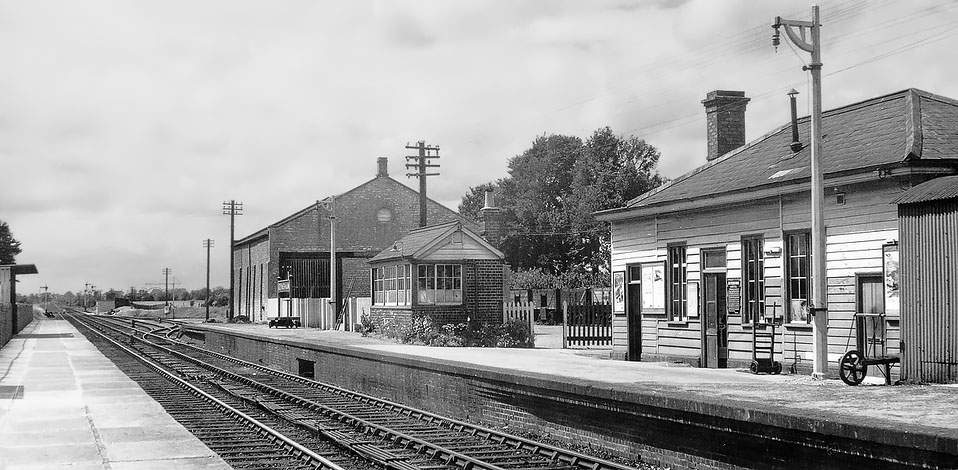
|
|
An excellent view of Eynsham station basking in the sun in July 1956. The station building, signal box and goods shed occupy the up platform, while the austere shelter on the extreme
left was the only building on the down platform. In the distance the goods loop and sidings can be seen, along with the down starter and up home signals. In the gap between the signal box and station building, a line of
wagons can be seen on the back siding.
Martin Loader Collection
|
|
Eynsham station was the main intermediate station on the Witney Railway, situated 3 miles 27 chains from Yarnton on the southern edge of the village. The station master's
house was situated on the up side near the level crossing. This 1905 view (above left) looking up Station Road towards the village centre shows the house on the left. From a slightly different angle, the house is pictured
on 4 April 1980 (above right), with the remains of the up platform in the foreground. Originally Eynsham station had just a single platform, the passing loop and second platform were added in 1944.
Martin Loader Collection & Martin Loader |
 |
|
A Fairford to Oxford train leaves Eynsham station in the late 1950s. Unfortunately the quality of this Kodachrome slide has been severely compromised by camera shake, but it does give a rare colour view of the station, with the
line of railway cottages on Station Road in the background.
Martin Loader Collection
|
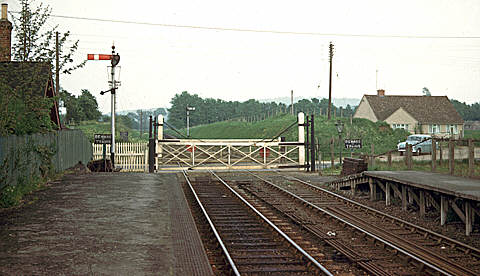 |
This view from the early 1960s shows the level crossing at Eynsham, looking towards Oxford. The 1944 prefabricated down platform can be seen on the right of the picture. This was
acquired by the Great Western Society and moved to Didcot in the 1980s.
Colour Rail |
|
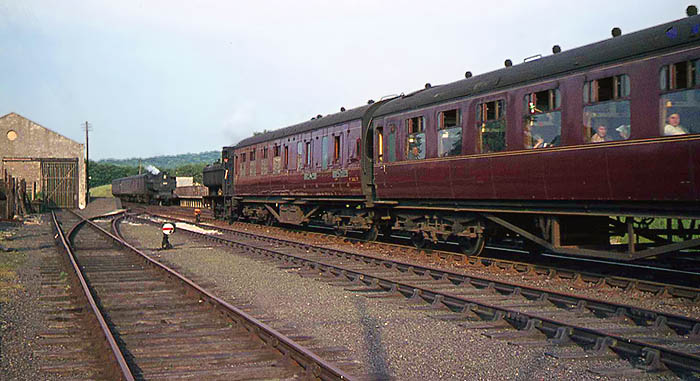
|
|
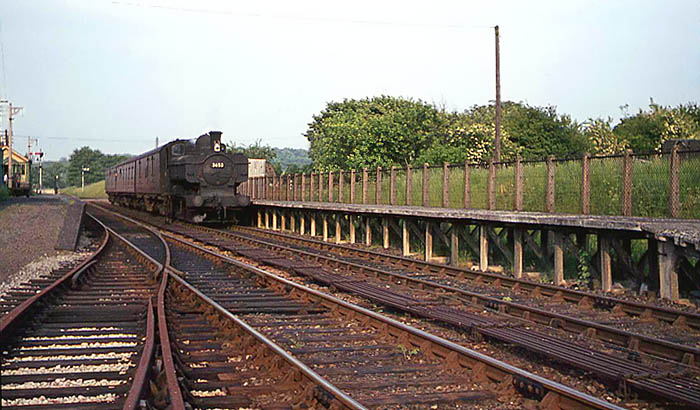
|
|
A fascinating pair of pictures showing trains crossing at Eynsham in June 1962. The top picture shows 57xx 0-6-0PT 3653 waiting in the down platform with the 18:49 Oxford to Fairford
service, while 74xx 0-6-0PT 7412 approaches with the 18:00 Fairford to Oxford train. The lower picture taken from a little closer to 3653, clearly shows the construction of the wartime down platform. Note how little used the
goods yard is by this date, as the track into the yard in the foreground is very rusty. Note also the point rodding between the two running lines.
Tony Doyle
|
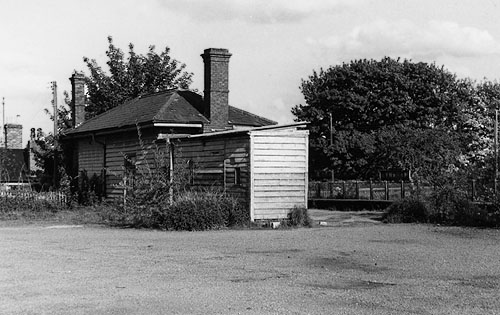 |
Eynsham station building, viewed from the north west in 1974, from what would now be called the car park, but in the branch line's operational days, would just be the approach road.
Martin Loader Collection
|
|
The abandoned trackbed through Eynsham station, with the wartime down platform, pictured in 1974. The track had been lifted three years earlier.
Martin Loader Collection
|
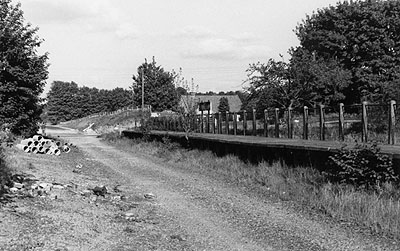 |
 |
Eynsham station building was one of the original Witney Railway Company's Malachi Bartlett timber buildings. It is pictured here (above & left) on 4 April 1980 and although ten years
after complete closure of the line, the green and cream paintwork is still clearly visible. The original building is the centre section around the white door, extensions on either end clearly indicated by different styles of
weatherboarding. This view (left) is looking along the platform towards the goods shed, the line to Witney disappearing between the small tree and the Tilley lamp post. The upper view shows the gents toilet extension at the
west end. Also visible to the right is the cycle store.
Martin Loader
|
|
At the rear of the yard was the weighbridge hut, seen here in April 1980, along with one of the ubiquitous corrugated iron stores that were so prevalent on GWR station sites. The longest
of the three sidings in the goods yard (normally used for coal) ended just to the left of this picture.
Martin Loader
|
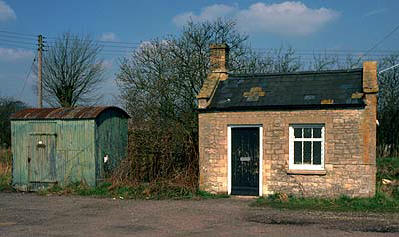 |
|
Eynsham station made the news in December 1927, when two fugitives on the run from the police after murdering an Essex policeman, staged a hold up at the station. Frederick Browne and
William Kennedy had somehow managed to drive their car along the track from the South Leigh direction late at night, and then on entering Eynsham station, encountered a porter, Frederick Castle, who not unnaturally wanted to
know what they were doing in the closed station so late at night. Browne & Kennedy then tied him up, and after an unsuccessful attempt to steal from the station safe, left Castle in the ground frame cabin at the end
of the yard.
|
|
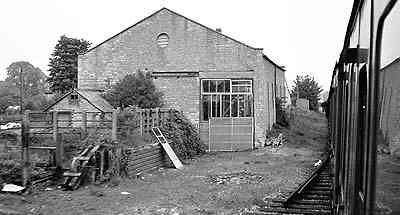
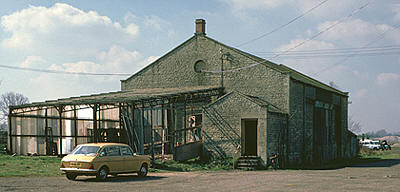
|
Two views of Eynsham goods shed. The upper view shows the shed from the western end, with the cattle dock in the foreground. The picture was taken from the 'London Division Branch Line
Tour' on 24 May 1969. By this date the line was worked as a long siding, and all superfluous track had been lifted, hence the truncated section of track visible here, which is the remains of the points leading to the
goods yard. The lower view shows the shed from the road approach on 4 April 1980, at a time when it was being used by the Oxford Playhouse as a theatre workshop. The makeshift extension behind the Austin Maxi still had
a section of track in situ at the time.
Stanley C. Jenkins & Martin Loader |
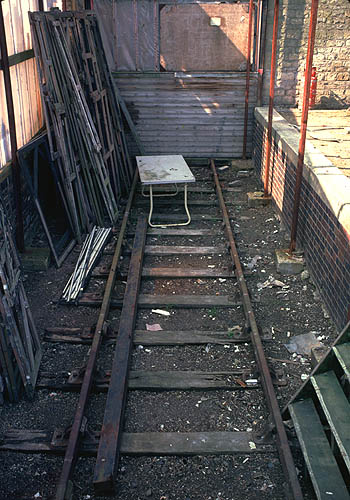 |
Several sections of track survived on the Fairford Branch after track lifting, usually because of the difficulty of removal. On 4 April 1980, nearly ten years after this section of
line closed, a section of rail was still clearly visible next to the eastern door of the former goods shed. At this time the building was used by the Oxford Playhouse, and a crude extension built largely of corrugated
plastic had been added to this end of the building (see above). A point worth noting is that this section of rail is clearly of some vintage, as it is inside keyed bullhead rail, i.e. the cast chairs have the wooden keys
securing the rail on the inside edge of the rail, rather than the outside which has been standard practice for a long time. Also the rail looks to be of smaller section than the standard 95lb bullhead type.
Martin Loader
|
|
The low winter afternoon sunlight highlights the remains of Eynsham goods shed on 8 February 1986. Somehow amid the demolition the virtually intact sliding door complete with its
guide wheels remains in an upright position. The pile of snow covered rubble in the foreground hides one of the sections of rail that survived when the remainder of the track was lifted in 1971.
Martin Loader |
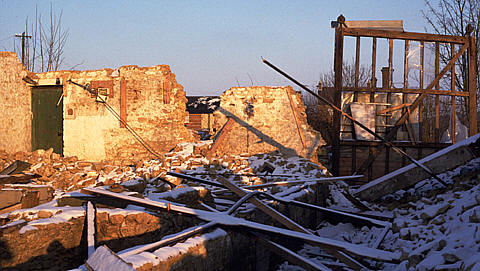
|
 |
The beginning of the end for Eynsham station. On 23 February 1985, work is underway on a new road to serve an industrial estate on the station site. The station building is left
marooned and will soon succumb to the development. The roundabout marks the site of the former level crossing. The former Down platform (a wartime addition) had been removed to the great Western Society's headquarters at
Didcot.
Martin Loader
|
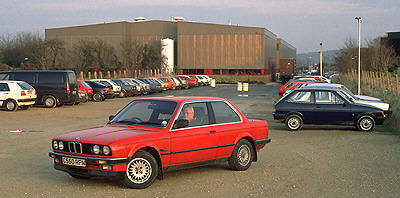 |
The site of Eynsham station on 8 December 1992 looking east with the large Oxford Instruments building dominating the background. The BMW is parked approximately on the site of the
points at the west end of the loops (SP427088), near the site of the ground frame in which Browne & Kennedy incarcerated porter Frederick Castle. A public footpath follows the course of the line here and another crosses
½ mile to the west (SP419087).
Martin Loader
|
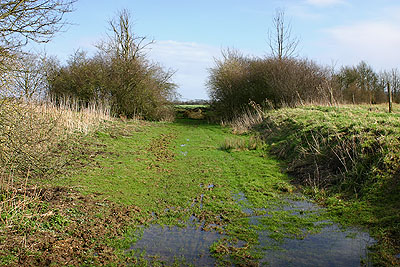 |
After passing the site of the farm road crossing leading to Lower Farm, a lengthy section of the trackbed has been grubbed out, and although the course of the line clearly shows up from the air (and on
Google Earth!), from ground level it is very hard to spot. Physical evidence of the line resumes again at SP407085, from where the picture on the left was taken on 28 February 2007. This shows that at this point the line was
in a shallow cutting. This is the view looking east, with the grubbed out section just beyond the bushes.
Martin Loader |
|
The line approaches South Leigh from the east on a falling gradient of 1 in 132 and ½ mile before the station crosses one of only two underbridges on the line (SP404084). This spanned
the South Leigh to Eynsham bridleway but was blocked up and replaced by an occupation crossing a little to the west. Given the fact that the route crosses a largely flat landscape, it is surprising that there were in fact any
bridges under the line at all, although obviously here the line is on a very slight embankment. It is not clear exactly when the bridge was filled in, but presumably the very narrow bore made it practically useless even for
the basic farm traffic of the nineteenth century. Erosion of the bank has resulted in the top of the 6 ft diameter arch now becoming visible again - seen here on 28 February 2007. It doesn't look as if much more than loose
earth has been used for the infilling, with the consequent settling over the years leading to a void appearing.
Martin Loader
|
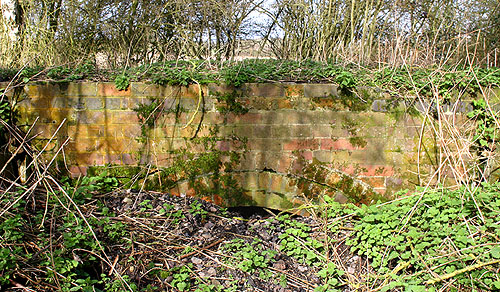 |
|